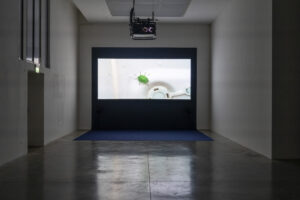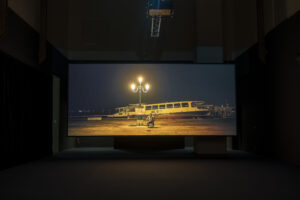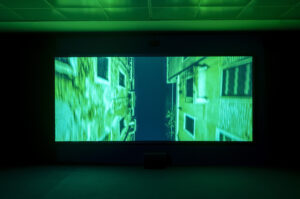Among the Italian art cities, Venice is perhaps the only one in which the emergencies of the globalized present, inextricably embodied in the vestiges of a sumptuous past, have continued to inspire artists and writers with mythologies and suggestions equally iconic as those associated with its unrepeatable historical identity. The large fast ships that violate the landscape, the floods, the tourist invasion, the water pollution, the progressive abandonment of the residents, the open-air garbage and the subsidence that threatens to make it sink, as well as exacerbating problems common to many other places of conflictual transition between past and present, are still today a source of infinite visual fascinations which, nourished by such a unique context, manage to translate into emblematic visions of the discomfort of our times without affecting the impeccable, painful beauty which constitutes the most distinctive feature of the soul of the place.

Yuri Ancarani, Atlantide 2017 – 2023, exhibition view at MAMbo, photo Ornella De Carlo, courtesy Settore Musei Civici Bologna | MAMbo – Museo d’Arte Moderna di Bologna
The video artist and film-maker Yuri Ancarani (Ravenna, 1972) started from these impressions to make the film Atlantde, previewed in the Orizzonti section of the Venice Film Festival in 2021 and, subsequently, in numerous international festivals, which is now the fulcrum of the current exhibition at MAMbo. The feature film is presented here at the end of an immersive journey of unpublished video installations where the imaginaries linked to the fate of the city and its inhabitants (which in the film shine through as if against the light in the narrative rarefactions of a human story and a breathtaking soundtrack) are refracted and multiplied.

Yuri Ancarani, Atlantide 2017 – 2023, exhibition view at MAMbo, photo Ornella De Carlo, courtesy Settore Musei Civici Bologna | MAMbo – Museo d’Arte Moderna di Bologna
The title Atlantde, from the name of the legendary island that the gods sank into the sea «in a single day and night of misfortune», first mentioned in the 4th century BC. by Plato in the dialogues Timaeus and Critias, in addition to evoking the geological upheaval of anthropic origin that most threatens its survival, universalizes this sinking by extending it to that of its adolescents in an abyss of degraded relationships, irreversibly marked by the disintegration of the social fabric and environmental integrity. The protagonists of the film are young people from the lagoon island of Sant’Erasmo, whose lives the artist, accustomed to working at the intersection between documentary cinema and contemporary art, has closely followed, entering firsthand their daily life made of parties, rivalries, romantic relationships and courage challenges.

Yuri Ancarani, Atlantide 2017 – 2023, exhibition view at MAMbo, photo Ornella De Carlo, courtesy Settore Musei Civici Bologna | MAMbo – Museo d’Arte Moderna di Bologna
The research focuses on the phenomenon of illegal racing with small boats, a sort of initiation rite (which for young males sanctions the transition to adulthood) focused on the development of ever more powerful engines, which transform small motorboats into dangerous racing cars. Almost all the characters are non-actors, of which the artist has taken real habits and dialogues as in a journalistic investigation, the theme of which was initially suggested to him by an article in the New York Times, which warned tourists about the aggressive baby gangs they could have run into in Venice, and from some local news reports relating to fatal accidents connected to this practice.

Yuri Ancarani, Atlantide 2017 – 2023, exhibition view at MAMbo, photo Ornella De Carlo, courtesy Settore Musei Civici Bologna | MAMbo – Museo d’Arte Moderna di Bologna
The intention of exploring areas that are not very visible in everyday life, on which the official media and public opinion itself operate more or less intentional processes of removal, leads the artist to elaborate a powerful negative apology for marginality, in which the irrepressible emergence of the intimate and pure roots of discomfort, sublimates their essence to the point of making them rise to manifestations of the new tragic passions aroused by the unresolved conflicts of our capitalist and globalized era. The stories of Daniele, Maila, Alberto and their peers stand out against the backdrop of a magnificent and at times semi-deserted Venice (part of the filming was done during the pandemic), whose features are also reinterpreted from an aesthetic point of view in a contemporary way.

Yuri Ancarani, Atlantide 2017 – 2023, exhibition view at MAMbo, photo Ornella De Carlo, courtesy Settore Musei Civici Bologna | MAMbo – Museo d’Arte Moderna di Bologna
Starting from the stroboscopic lights of the small boats (on which young people travel along the canals at night) which, intermittently projected onto the facades of the historic buildings, psychically distort the architecture, culminating in the ending, where a slow procession of motorboats turns into a shipwreck of the gaze in a game of reflections and duplication of the landscape taken from the point of view of the sailors in the reflection of the water, Venice seems to be reborn from the ashes of itself and reaffirm the imperturbability of its myth. But, this time, the reaffirmation does not translate into a new official image ready to be engulfed (and sold) to the highest bidder, but rather in a re-appropriation of places by the younger native generations, caught in their most fragile aspects, who share with the city the same endemic disease and an uncertain future.

Yuri Ancarani, Atlantide 2017 – 2023, exhibition view at MAMbo, photo Ornella De Carlo, courtesy Settore Musei Civici Bologna | MAMbo – Museo d’Arte Moderna di Bologna
The “environmental” impressions of the film expand and become more specific in the video installations that inhabit the Sala delle Ciminiere at MAMbo and the adjoining rooms, completely darkened so as to make them emerge as monumental dreamlike visions, suspended in a titanic space time but dramatically anchored in the contemporary. Here we find both works more directly derived from the documentary interest of Ancarani with respect to Venice (such as, for example, the shots of the demonstration against the large ships in which close-up details of the policemen in riot gear contrast with those of the unarmed participants, those of a rave in the lagoon where the slow passage of these gigantic boats has the effect of a sliding theatrical backdrop that overlaps the profile of the ancient buildings or the video-story of the boat transport of an electrical appliance from Burano to Rialto, seen through the movements of a bug on the fastening ropes) and works inspired by the emotional backgrounds of the characters, such as the long room on the right crossed by a maze of laser lights in which night shots of the Venetian palaces seen from the canal follow one another on the wall.

Yuri Ancarani, Atlantide 2017 – 2023, exhibition view at MAMbo, photo Ornella De Carlo, courtesy Settore Musei Civici Bologna | MAMbo – Museo d’Arte Moderna di Bologna
In both cases, the artist creates a powerful portrait of Venice in which the viewer, identifying with the gaze of its native inhabitants, is no longer such, but actively participates in their emotional states and in the resistance struggle against the implosion of the city of which they are, perhaps not entirely consciously, interpreters.
Info:
Yuri Ancarani. Atlantide 2017 – 2023
curated by Lorenzo Balbi
MAMbo – Museo d’Arte Moderna di Bologna, Sala delle Ciminiere
2/02/2023 – 7/05/2023
www.mambo-bologna.org
Graduated in art history at DAMS in Bologna, city where she continued to live and work, she specialized in Siena with Enrico Crispolti. Curious and attentive to the becoming of the contemporary, she believes in the power of art to make life more interesting and she loves to explore its latest trends through dialogue with artists, curators and gallery owners. She considers writing a form of reasoning and analysis that reconstructs the connection between the artist’s creative path and the surrounding context.






NO COMMENT